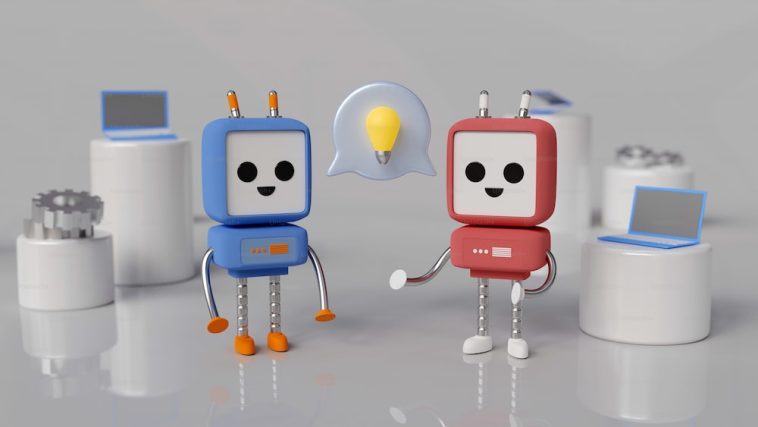Introduction.
Welcome to the world of voice-enabled AI interactions! Making a voice chatbot using Python opens up a realm of possibilities where you can create conversational agents that respond to spoken language, making interactions with technology feel more natural and seamless.
As voice technology continues to advance, integrating voice capabilities into chatbots has become a game-changer, enabling more intuitive and engaging user experiences.
Python, with its robust libraries and frameworks, offers an ideal platform for developing voice chatbots.
By leveraging speech recognition, text-to-speech, and natural language processing libraries, you can build interactive voice chatbots that understand user inputs and generate spoken responses.
In this guide, we’ll take you through the process of creating a voice chatbot using Python, step by step.
From setting up speech recognition to implementing conversational logic and generating voice responses, you’ll gain the knowledge and tools to embark on your journey of building voice-enabled chatbots.
So, whether you’re a Python enthusiast eager to explore voice technology or an AI developer looking to expand your skillset, let’s dive into the world of making voice chatbots using Python and unlock the potential of natural and intuitive interactions! Get ready to bring your chatbot to life with the power of voice!
What Is a Chatbot?
A chatbot is an artificial intelligence (AI) program designed to interact with users through conversation, typically in a text-based format.
It is a software application that uses natural language processing (NLP) techniques to understand and interpret user inputs and provide appropriate responses.
Chatbots can be found on various platforms, such as websites, messaging apps, or virtual assistants.
Chatbots can be classified into two main types: rule-based and AI-powered. Rule-based chatbots follow predefined rules and patterns to respond to user queries.
They rely on a set of if-then statements or decision trees to guide the conversation. On the other hand, AI-powered chatbots utilize machine learning and NLP algorithms to understand and generate human-like responses.
These chatbots learn from vast amounts of data and improve their performance over time. The capabilities of chatbots vary depending on their design and purpose.
Some chatbots are programmed to handle specific tasks or provide information on a particular topic, while others are designed for more complex and interactive conversations.
What are The Benefits of Chatbots for My Business?
One such solution that has gained significant popularity is the implementation of chatbots. These AI-powered conversational agents offer numerous benefits to businesses across various industries.
In this article, we will explore the advantages of chatbots and how they can revolutionize your business operations.
1. Enhanced Customer Support.
Chatbots provide businesses with an efficient and scalable solution for customer support. They can handle a wide range of inquiries and provide instant responses, ensuring customers receive prompt assistance around the clock.
Chatbots can answer frequently asked questions, guide users through processes, and even resolve common issues.
By reducing response times and improving accessibility, chatbots significantly enhance customer satisfaction and loyalty.
2. Cost and Time Savings.
Implementing chatbots can lead to substantial cost and time savings for businesses. Unlike human agents, chatbots can handle multiple customer inquiries simultaneously without experiencing fatigue.
This scalability allows businesses to serve more customers efficiently, reducing the need for extensive customer support teams.
Additionally, chatbots operate 24/7, eliminating the constraints of traditional working hours and reducing labour costs associated with staffing customer service personnel around the clock.
3. Increased Efficiency and Productivity.
By automating repetitive and mundane tasks, chatbots free up human resources to focus on more complex and value-added activities.
Chatbots can handle tasks such as order tracking, appointment scheduling, and information retrieval, reducing the workload on employees.
This increased efficiency translates into improved productivity and allows businesses to allocate human resources to areas that require specialized skills or personal attention.
4. Personalized Interactions and Recommendations.
AI-powered chatbots can analyze customer data and preferences, enabling them to deliver personalized interactions and recommendations.
By understanding user behaviour, chatbots can provide tailored suggestions, product recommendations, or targeted promotions.
This personalized approach enhances the customer experience, fosters engagement, and increases the likelihood of conversions and repeat business.
5. Data Collection and Analytics.
Chatbots act as valuable data collection tools for businesses. Through conversations with customers, chatbots gather valuable insights into customer preferences, pain points, and behaviour patterns.
This data can be analyzed to identify trends, understand customer needs, and make data-driven business decisions.
Chatbot analytics provide businesses with a deep understanding of customer interactions, allowing them to refine their strategies and optimize their offerings.
6. Improved Lead Generation and Sales.
Chatbots can play a crucial role in lead generation and sales. By engaging with website visitors or app users, chatbots can initiate conversations, capture leads, and guide potential customers through the sales funnel.
They can provide product information, assist in product selection, and even facilitate transactions. With their ability to provide instant responses and personalized recommendations, chatbots contribute to higher conversion rates and increased sales revenue.
7. Seamless Integration with Multiple Channels.
Chatbots can seamlessly integrate with various communication channels, including websites, messaging apps, social media platforms, and even voice assistants.
This versatility allows businesses to meet customers wherever they prefer to engage, providing a consistent and unified experience across channels.
Whether customers reach out through a website chat widget or a messaging app, chatbots can offer the same level of support and information, ensuring a cohesive brand experience.
8. Quick and Accurate Information Retrieval.
Chatbots can access vast amounts of information and retrieve it instantly. This capability enables them to provide accurate and up-to-date information to customers in real-time.
Whether it’s details about product specifications, pricing, or order status, chatbots can retrieve the information quickly and efficiently.
This not only saves time for customers but also ensures they receive accurate and consistent information, reducing the chances of misunderstandings or errors.
9. Language Support and Global Reach.
With the power of natural language processing, chatbots can communicate in multiple languages, catering to customers from different regions and demographics.
This language support enables businesses to expand their reach and engage with a global customer base.
Chatbots can overcome language barriers, ensuring effective communication and support for customers worldwide.
By providing localized experiences, businesses can foster stronger connections and build trust with their international customers.
10. Continuous Learning and Improvement.
AI-powered chatbots can learn and improve over time. Through machine learning algorithms, chatbots can analyze customer interactions, identify patterns, and continuously refine their responses and capabilities.
This means that the more customers engage with the chatbot, the smarter and more accurate it becomes.
Chatbots can adapt to evolving customer needs and preferences, ensuring that they provide the most relevant and helpful information and support.
How Do I Make a Voice Chatbot Using Python?
In the ever-evolving landscape of artificial intelligence, voice-enabled interactions have emerged as a transformative force, shaping the way we interact with technology.
Voice chatbots, or conversational agents that respond to spoken language, have become increasingly prevalent, offering more intuitive and engaging user experiences.
If you’re curious to explore the exciting world of voice technology and Python programming, learning how to make a voice chatbot is a thrilling journey worth embarking on.
Python, with its versatility and rich ecosystem of libraries, provides an ideal platform for developing voice chatbots.
By harnessing Python’s speech recognition, text-to-speech, and natural language processing libraries, you can create interactive voice chatbots that understand user inputs and generate spoken responses.
In this article, we’ll guide you through the process of making a voice chatbot using Python, step by step.
Whether you’re a Python enthusiast eager to explore voice technology or an AI developer looking to expand your skill set, this guide will equip you with the tools and knowledge to build your own voice-enabled conversational agent.
Step 1: Set Up Speech Recognition.
The first step in creating a voice chatbot is to set up speech recognition. Python’s SpeechRecognition library allows you to capture and interpret spoken language.
This library supports various speech recognition APIs, such as Google Web Speech API and Microsoft Bing Voice Recognition, giving you flexibility in choosing the best option for your chatbot.
Step 2: Implement Natural Language Processing (NLP).
Natural Language Processing (NLP) is the backbone of any chatbot’s intelligence. By integrating NLP libraries like NLTK or spaCy, you can process user inputs, extract intents, and understand the context of the conversation. NLP enables your chatbot to respond more intelligently and contextually to user queries.
Step 3: Design Conversational Logic.
Building effective conversational logic is essential for a user-friendly chatbot. Define the possible user intents and map them to appropriate responses.
Create a decision tree or implement machine learning algorithms to determine the most suitable reply based on user inputs. Continuously iterate and improve the chatbot’s conversational flow.
Step 4: Implement Text-to-Speech.
To make your chatbot more engaging, implement text-to-speech functionality using libraries like pyttsx3 or gTTS.
This allows your chatbot to convert text responses into natural-sounding speech, enhancing the user experience.
Step 5: Handle Voice Inputs and Outputs.
Integrate the speech recognition and text-to-speech functionalities to handle voice inputs and outputs seamlessly.
Capture voice inputs, process them using your NLP logic, and generate voice responses to create a natural and interactive conversation between the user and the chatbot.
Step 6: Optimize Performance and User Experience.
Test your voice chatbot rigorously to ensure its accuracy, responsiveness, and overall performance. Optimize the chatbot’s response times and reduce potential errors to create a smooth and satisfying user experience.
Step 7: Deployment and Integration.
Once your voice chatbot is ready, deploy it to the desired platform or application. Whether it’s a website, mobile app, or smart speaker integration, ensure a seamless deployment and integration process for users to access the chatbot effortlessly.
Step 8: Continuous Improvement.
A successful voice chatbot is never static. Continuously collect user feedback and analytics to identify areas for improvement.
Use this data to iterate on your chatbot’s conversational logic, optimize performance, and enhance user satisfaction over time.
Conclusion.
Creating a voice chatbot using Python is an exhilarating endeavour that unlocks the potential of voice technology and artificial intelligence.
Python’s rich ecosystem of libraries, combined with the power of speech recognition and NLP, allows you to build interactive and engaging voice-enabled conversational agents.
Whether you’re developing voice assistants, customer support chatbots, or innovative virtual companions, the process of making a voice chatbot in Python offers endless possibilities for seamless and intuitive interactions.
Embrace the power of voice technology, dive into the world of Python programming, and embark on your journey of building voice chatbots that elevate user experiences to new heights.
Let your chatbot be the bridge between human communication and cutting-edge technology, shaping the future of AI-driven voice interactions. Happy coding!






GIPHY App Key not set. Please check settings